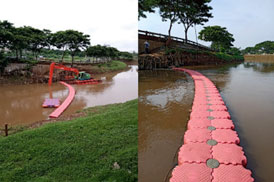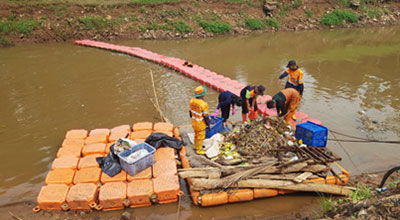
ここからコンテンツです。

Jakarta's River Plastic Content Revealed!
Fact-finding Survey through Joint Research Takanobu Inoue
Prof. Takanobu Inoue of Toyohashi University of Technology conducted a joint research project with his research team entitled "Estimation of amount of release of plastics to the ocean in Indonesia" (2019 - 2022) under the Japan Society for the Promotion of Science Bilateral Exchange Program. In Jakarta (Indonesia), waste being carried downstream is trapped by a floating contraption involving floats attached to the top of fence posts across the river. The collected garbage was sorted to clarify how much plastic was in the waste. As a result, some 78% was deemed to be plastic, equating to an estimated daily discharge rate into the ocean of 7.7 - 12.6g/person/day.

Marine pollution caused by microplastics has become a global environmental issue, with ever more plastics being detected in the bodies of marine and avian wildlife. Indonesia is the world's second largest emitter of plastics into the ocean, while Southeast Asian countries in general also lag behind in creating and managing plastic waste. Away from urban areas, waste is not generally collected, with domestic waste typically being thrown away behind houses or along rivers. Although the proportion of plastic in such waste has recently increased, there has not been any change in how it is being disposed of, while the actual volume of garbage disposed is also increasing due to economic growth. Such waste is carried downstream to the ocean via rivers, especially when currents surge after heavy rainfall. In order to clarify the true situation, Prof. Inoue’s research team initiated a study using a variety of methods to estimate how much plastic is being discharged into the ocean.
As this research was the first study into waste runoff conducted by this team, they began by assessing the best way to collect data. Various methods were tried, including having students line up across the river and collect floating garbage for 10 minutes, or by using nets to collect the trash. However, while assessing some rivers in Jakarta, it was observed that floating waste was being trapped as it flowed downstream by floating booms installed on fence posts across rivers. A hydraulic shovel was set up on the riverbank to remove the accumulated waste, which was then loaded onto trucks to be transported to a waste disposal site. The research team sampled this collected waste, and after sorting, determined that the average ratio of plastics in this waste was 78%; of which, PET bottles and store-issued plastic bags accounted for more than half. However, the proportion of straws – currently considered problematic in Japan – was small.
Based on the amount recovered, we estimated that the daily amount that would be discharged into the ocean if there were no collection equipment would be in the range 7.7 to 12.6g/person/day. The most widely used estimate at the moment for the daily amount of plastic discharged into the ocean from Indonesia is 18.9g/person/day. Although this is a lower value, it nonetheless indicates that a vast amount of plastic is being discharged into the ocean via river systems.
These research results have been published in the Marine Pollution Bulletin (Issue 182) – an international journal.

This research team has been conducting a "Survey into Plastic Volume Discharged via Rivers in Indonesia" as Grant-in-Aid for Scientific Research since this fiscal year. The research targets rivers in cities and nearby rural areas in Indonesia – from which waste is not collected directly. A similar survey is also to be conducted in Japan, and by comparing the results, we intend to clarify more accurately how much plastic is discharged across Indonesia, while also discussing measures with Indonesian researchers to reduce plastic discharge into the ocean.
Furthermore, through this research, we also strive to bolster the skills of environmental engineering researchers by teaching basic research methodology for environmental engineering to young Indonesian researchers with environmental engineering credentials.
This research was supported by JSPS (JPJSBP 120198104).
Reference
Mega Mutiara Sari, Pertiwi Andarani, Suprihanto Notodarmojo, Regil Kentaurus Harryes, Minh Ngoc Nguyen, Kuriko Yokota, Takanobu Inoue, Plastic pollution in the surface water in Jakarta, Indonesia, Marine Pollution Bulletin, 182 (2022).
https://doi.org/10.1016/j.marpolbul.2022.114023
ジャカルタの河川のプラスチック量が明らかに!
共同研究による実態調査井上 隆信
豊橋技術科学大学 井上隆信教授らの研究チームは、日本学術振興会二国間交流事業により「インドネシアにおけるプラスチック類の海洋への排出量の推計」(2019-2022年)を研究課題に共同研究を実施しました。インドネシアのジャカルタでは、フェンスの上部にフロートを取り付けて浮かせた装置を河川の横断面に設置して、流下するゴミを回収しています。ゴミの中に含まれるプラスチックの量を明らかにするため、この回収物を分別したところ、78%がプラスチックであり、また海洋への流出量の推計値の範囲は、7.7~12.6g/人/日であることが分かりました。
マイクロプラスチックによる海洋汚染は世界的な環境問題であり、海洋生物や鳥類の体内からのプラスチックの検出が報告されています。インドネシアは世界で2番目にプラスチック類の海洋への排出量の多い国であり、また東南アジアの国々ではプラスチックゴミに限らず、廃棄物対策そのものが遅れています。都市部を除けばゴミの収集すらなく、家庭から出るゴミは家のうらや河川沿いに廃棄されています。近年、ゴミ中のプラスチック含有量は増加しているにもかかわらず、ゴミは従前通りに廃棄されていることに加え、経済発展に伴うゴミの廃棄量も増加しており、これらのゴミはスコールなど水の移動とともに河川に流出し、そのまま海洋へと流出しています。井上教授ら研究チームは、海洋へ排出されるプラスチック類の量を様々な手法を用いて推計し、その実態を明らかにすることを目的に研究を開始しました。
研究チームは、ゴミの流出に関する研究は初めてであったため、まず、データの取得方法から検討しました。学生が川の横断方向に並び、流れてくるゴミを10分間回収する方法やネットを用いた回収など、いろいろな方法を試しました。そして、ジャカルタ市内のいくつかの河川を見に行くなかで、フェンスの上部にフロートを取り付けて浮かせた装置(Floating booms)を河川の横断面に設置して、流下するゴミを回収していることに気づきました。川岸には油圧ショベルが設置され、溜まったゴミを陸揚げし、トラックに積んでゴミ堆積場に運んでいました。この回収したゴミの一部を譲り受けて分別をしたところ、ゴミに含まれるプラスチックの割合は平均78%で、その内訳は、商店などで渡されるレジ袋とペットボトルが半分以上を占める一方、日本で現在問題視されているストローの割合は僅かでした。
回収量から、このような回収装置がない場合の海洋への流出量を試算したところ、推計値は7.7~12.6 g/人/日の範囲であることが分かりました。現在、広く用いられているインドネシアからの海洋への流出量の推計値は18.9g/人/日であり、その値よりは少ないものの多量のプラスチックが河川を通じて海洋に流出している実態を明らかにすることができました。
研究チームは、科学研究費「インドネシアを対象としたプラスチック類の河川からの流出量の実態調査」を今年度から実施しており、河川で直接ゴミの回収を実施していないインドネシアの都市とその近郊の農村地帯の河川を対象として、プラスチックの流出量の調査を実施しています。また、日本でも同様の調査を実施し、比較することで、インドネシアの流出量の多さを明らかにするとともに、プラスチックの海洋流出量を削減する方策について、インドネシアの研究者と共同で検討していきます。
またこの研究を通じてインドネシアの若手の環境工学研究者に環境工学の基本的な研究手法を伝えることにもつながり、環境工学研究者の質の向上を図ることも目指しています。
なお、この研究結果は、国際誌のMarine Pollution Bulletin の182号に掲載されました。
Researcher Profile

| Name | Takanobu Inoue |
|---|---|
| Affiliation | Department of Architecture and Civil Engineering |
| Title | Professor |
| Fields of Research | Water Environment Engineering / Sanitary Engineering |
ここでコンテンツ終わりです。
